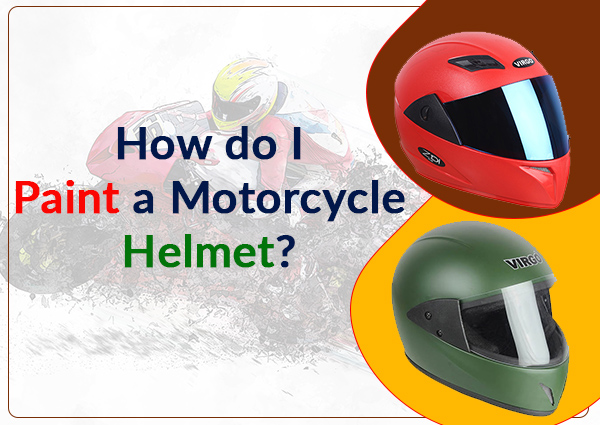How Do I Paint A Motorcycle Helmet
In the following, we will be discussing an important topic that is “How do I paint a motorcycle helmet?” and will discuss it in detail within the article. Restoring a classic motorbike typically includes repainting the chassis or panels. But the owners often want to go further with the appearance of both the bike and riding gear. Personalizing riding gear by painting helmets or by simply adding studs to a leather jacket, for instance, is actually something motorcyclists have done from their inception or from the start. Both of these examples need skill and patience.
The good news is that the home mechanics with access to basic painting equipment (i.e.: spray gun, airbrush, and an angle sander/polisher) can transform a standard helmet into a custom-designed unit. New helmets come in a range of styles and paint finishes, as well as prices. But a plain white or black helmet is going to be less costly and a good starting point for a custom paint job. However, it’s important to check with the helmet manufacturer and paint supplier to confirm that the chemicals you intend to use are compatible with the helmet’s base material.For this motorbike helmet manufacturers are doing a great work.
1. Preparation
The process starts by preparing the working area and getting the appropriate tools ready. The work area must be clean dry and dust-free. Mounting the helmet at an acceptable height on a workbench with a mannequin Styrofoam™ head will make the task easier. Full face helmets should have their visors removed, along with any plastic attachments such as vents. The first part of the procedure is to decrease the helmet with a mild solution of some general household detergent or dish-washing liquid. This should be followed by employing proprietary wax and grease remover. The artist who painted the helmet shown here uses Acetone, but this is a dangerous chemical and should only be used by painters with knowledge of the safety requirements.
As the human hands, as well as fingers, carry greasy deposits, it is vital to wear disposable gloves, like Latex gloves, especially when handling the helmet. After degreasing, the surface finish must be sanded using fine wet sandpaper (400 grades) to remove the sheen and give the new base paint a suitable surface to adhere to. When the whole helmet surface has been sanded to give a flat dull look, it must be cleaned off using a damp cloth. When the helmet has dried, then the surface must be wiped off using a tack rag to remove or get rid of small dust particles.
2. Masking Out The Design
The helmet and any remaining fittings should now be masked-off. For this method/technique, a paper, which is clear of any sort of printing and has a decent as well as good quality should be used along with 1/8″ width of the Vinyl tape (the narrow or to say skinny tape makes tough shapes or bending around corners much easier). The first coat/s of paint (the base coat) can now be applied; however, it is very important to allow the paint to dry before applying another coat to avoid runs.Once the base coat has dried, the design can be applied. Again, it’s vital to avoid skin contact with the surface to avoid grease spots. Taking care with the application of the masking tape to confirm symmetry, for instance, will pay off in the finished helmet.
3. Painting Different Colors
For example, in order to separate the different colors, only those areas were left exposed, where the paint had to be applied, whereas areas that will get a different color were usually masked off. After leaving sufficient time for drying, the newly colored area is masked off and a different color applied to the newly exposed area. This process is repeated until all the colors have been applied.
4. Clear Coat
Removing the masking tape can only be undertaken when the various colors have completely dried and should be done slowly to ensure that the paint is not lifted during the peeling. A tack cloth ought to be used again to get rid of any dust particles trapped beneath the tape. The final coat to apply is a Urethane clear coat (it is very important to use a propitiatory respirator during this process, available from major auto stores). The additional coats applied, the more apparent the depth of paint will be. Typically four coats of clear coat are sufficient.
After the clear coats dry (typically twelve to twenty-four hours) the whole surface should be wet sanded to get rid of any dust particles and tiny imperfections with 1500 to 2000 grade paper. Finally, the whole surface ought to be buffed (especially around any sanded areas) with an acceptable polishing compound.
5. Reassembly
When the final clear coat has dried and been polished for the final time, the various attachments may be put back on the helmet. Although the process of custom painting is labor-intensive, the finished product is something the owner will be proud of and one that will be admired by many.

